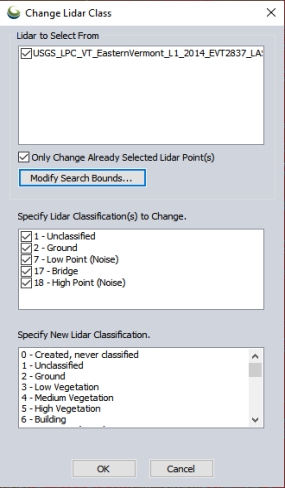Activating the Global Mapper Pro will add the Lidar Toolbars as an additional component to the Global Mapper User Interface.
![]() This tool requires Global Mapper Pro.
This tool requires Global Mapper Pro.
Like other Global Mapper toolbars, this interface may be activated and deactivated in the View > Toolbars menu. See Toolbar Visibility and Customization for more information on enabling toolbars and customization.
On the toolbar are options to change the draw or color mode, quickly classify or re-classify selected points, and
auto-classify Lidar points.
Lidar
Lidar (Manual Classification)
 Lidar Draw Mode
Lidar Draw Mode
The Lidar Toolbar features a drop down menu for changing the draw or color mode of displayed lidar points, which allows users to easily select the display characteristics of the point cloud.
Lidar Tools
Filter Lidar Data – Allows the user to filter out lidar points by classification. Also allows for changing the color or classification groups of Lidar classes. See more information on changing the class properties. Additional advanced filtering tools can be applied while running an auto-classification, or by selecting Lidar Points with the digitizer tool.
Select Lidar Classes – Quick select lidar based on classification or return type. This dialog can also be used to access class name, color and group for customization.
Select Lidar by Distance – Perform a spatial query to select lidar points near other points or near lines using a 2D or 3D distance threshold.
Find Duplicate Lidar – Delete points XYZ locations. You can also optionally require other attributes to match as well as XYZ.
Spatially Thin Lidar Layers – Thin a dense lidar point cloud using one of the available thinning methods. This is especially good for thinning dense photo-generated point clouds, such as those from Pixels to Points™.
Apply Color to Lidar Points – Applies color values from loaded imagery to Lidar points based on X, Y location values. Color values can include R,G,B values from true color imagery, intensity values, or values from multi-band imagery or raster calculations for LAS versions 1.4.
Lidar QC - Compare/ Adjust Elevations to Control Points – Control points may be compared to nearby Lidar points. This tool reports the differences and RMSE between the control points and nearby LiDAR points. It can also be used to adjust the point cloud so the points match the control elevations.
Fit Point Clouds – Automatically align one point cloud with another.
Compare Point Clouds – Calculate the change between 2 point clouds beyond a specified minimum. This performs a change detection to find points that have different beyond a minimum allowed distance.
Create Mesh from Selected Lidar – Convert the selected lidar points into a 3D mesh surface.
Create Swath Separation Image - Generate an image showing the vertical offset between lidar swaths.
Pixels to Points™- Using drone- or UAV-collected images and a set of surveyed ground control points (optional) generate a 3D point cloud, seamless orthoimage and/or 3D mesh output.
Automatic Point Cloud Analysis - This tool contains Global Mapper's broad toolset for point cloud classification, segmentation, and feature extraction.
Select Lidar Segments - With the digitizer tool, enable this option to select all points in a specific segment.
Manually Classifying Points
Global Mapper Pro
also allows the user to manually classify or re-classify selected Lidar points.
To use the classification buttons found on the Lidar Toolbar,
select a group of lidar points with the Digitizer Tool
and click on the button corresponding to the classification you wish to use.
The manual classification options available on the toolbar are:
Classify – Ground
Classify Selected Lidar Points as Ground (Class 2)
Classify – Vegetation Low
Classify Selected Lidar Points as Vegetation Low (Class 3)
Classify – Vegetation Medium
Classify Selected Lidar Points as Vegetation Medium (Class 4)
Classify – Vegetation High
Classify Selected Lidar Points as Vegetation High (Class 5)
Classify – Building
Classify Selected Lidar Points as Building (Class 6)
Classify – Transmission Tower
Classify Selected Lidar Points as Transmission Tower (Class 15)
Classify – Wire (Conductor)
Classify Selected Lidar Points as Wire (Conductor) (Class 14)
Classify – Water
Classify Selected Lidar Points as Water (Class 9)
Classify – High Noise
Classify Selected Lidar Points as High Noise (Class 18)
Classify – Model Key-point
Classify Selected Lidar Points as Model Key-point (Class 8)
Change Lidar Class
Use the Change Lidar Class tool to bulk modify the classifications of loaded or selected points so they all update to the selected new classification.

The Change Lidar Class tool will change the class of all points matching the specified class.
Only Change Already Selected Lidar Point(s)– Select Lidar points with the digitizer prior to selecting this tool from the Lidar Toolbar, then check this option to only updated selected points matching the Classification to Change.
Modify Search Bounds –Use this to specify a smaller area of Lidar Points for which to change the class.
Specify Lidar Classification(s) to Change – Check which existing lidar classes should be modified.
Specify New Lidar Classification–Highlight the desired new lidar classification for all of the specified points to change to.
